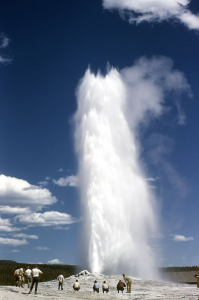From Alaska to Kentucky, Hawaii to New York, there are countless breathtaking natural wonders which you should put on a bucket list.
If you can’t travel to them in person soon, here’s a great virtual list you can enjoy anytime, wearing daytime pajamas or whatever you want!
Grand Canyon, Arizona
For the last two billion years, the Colorado River has been slowly carving out a path in the southern Arizona landscape. At some places, the deep gorge is over a mile deep and 18 miles wide.
It spans 277 miles of the Colorado Plateau, and much of it is accessible by visiting the Grand Canyon National Park, where you can hike down into the canyon’s valleys, fish the river, or view the expanse from one of the many vista viewing places along the river. Especially at sunrise and sunset, the spectacular reds and yellows and browns of the rock shine, showing off a natural masterpiece.
Old Faithful, Wyoming
Geysers are relatively rare formations, usually near volcanoes, where water under the earth’s crust makes contact with volcanic magma, causing the hot, pressurized water to come rushing to the earth’s surface, either seeping out or bursting through the earth.

A wide variety of geysers can be seen in Yellowstone National Park in Wyoming and Montana. The most famous geyser is Old Faithful, which erupts about every ninety minutes. When it does, thousands of gallons of boiling hot water spray up to about 150 feet into the air, like Mother Nature’s own epic fountain.
Niagara Falls, New York
Another wet wonder is Niagara Falls, on the border between New York state and Ontario, Canada. Three water falls where the Niagara River drains into Lake Ontario form the international wonder.
The highest of the three, Horseshoe Falls, plummets about 188 feet. At the widest, the river is more than half a mile across. The immense falls are well known for their beauty, and visitors can hike near the falls and take tours on the water below the falls, getting close enough to feel the misty spray.
Entertainers and daredevils have long been attracted to the falls, and at least 15 people have intentionally gone over the falls, not all of them surviving the journey.
Death Valley, Nevada
Famous for its lack of water, Death Valley is one of hottest and driest places on earth. It holds the record for being the hottest place on earth, at 134 degrees Fahrenheit.
In spite of its foreboding name, Death Valley is a beautiful place, with wildlife and scenic wonders. Because it is on the cusp of the Sierra Nevada mountain range, parts of Death Valley are very high in elevation, with Telescope Peak measuring at over 11,000 feet. The lowest point is at the bottom of the basin, and is 282 feet below sea level.
You can visit Death Valley, but it is best to plan ahead to ensure you are prepared for the intense and varied weather you’ll experience.
Mt. Kilauea Volcano, Hawaii
It’s hard to imagine, but the Hawaiian islands were all formed by volcanic activity, and many volcanoes are still active on the islands.
Mt. Kilauea is the most active volcano in the island chain, and by some measures, the most active in the world. Kilauea is a shield volcano, meaning it erupts slowly and predictably. It rarely spews lava, but instead has been slowly erupting for over 35 years! In that time, it has consumed roads, beaches and even villages, and has expanded the size of the island of Hawaii.
Kilauea provides a fascinating landscape, and visitors can hike along newly created volcanic terrain, see flowing lava, and enjoy the amazing biodiversity of the island, with species native only to Hawaii.
Mammoth Cave, Kentucky
Mammoth Cave is the world’s longest known cave system, with over 400 miles of tunnels currently known and mapped; and each year more existing tunnels are identified.
The cave system was formed over millions of years as some rocks were dissolved by water seeping through the ground, while other types of rocks remained. Underground rivers still exist, slowly modifying the subterranean landscape. Visitors who aren’t claustrophobic or afraid of the dark can take guided walking tours of the caves, seeing some of nature’s most interesting underground creations.
Hubbard Glacier, Alaska
About 75 miles long and six miles wide where it meets the ocean, Hubbard Glacier is a giant and active glacier spanning both Alaska and Canada. Ice slowly flows from the top of the glacier to the ocean, where pieces or “calves” break off into the ocean. It takes 400 years for ice to travel from the start of the glacier to the water!
Visitors can experience the glacier by hiking around it, ice hiking on it, or taking a ferry tour of the bay to witness calving. The colors of the glacier are vibrant and breathtaking, and the scenery is otherworldly. Hiking along Hubbard Glacier is a once in a lifetime experience, and with climate change impacting the glaciers, it may not be around for our grandchildren to visit!
There are so many amazing places to visit across the United States, this list can’t even cover them all, but at least it’s a start!






